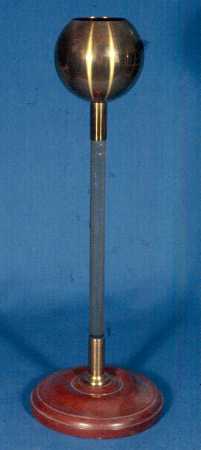 |
This shows that that that distance the inductive action of C is entirely
exerted upon the interior of A, ... If C is made to touch the bottom of
A, all of its charge is communicated to A, ... and C, upon being
withdrawn, ... is found to be perfectly discharged." (From a letter written
by Michael Faraday to Richard Phillips, the editor of Phil. Mag.
on February 4, 1843. The diagram is from L. Pearce Williams, Michael
Faraday, A Biography (Simon and Schuster, New York, 1971), pg
374)
And so introductory physics students have been studying
the Faraday Ice Pail Experiment ever since, learning that in an electrically-conducting
body, the charge resides on the surface.
Two almost identical ice pails at the top are from Colby
College (left) and the University of Vermont (right). At the left below
is an ice pail from Allegheny College, and the one at the right is in the
Smithsonian Institution collection. |
 |